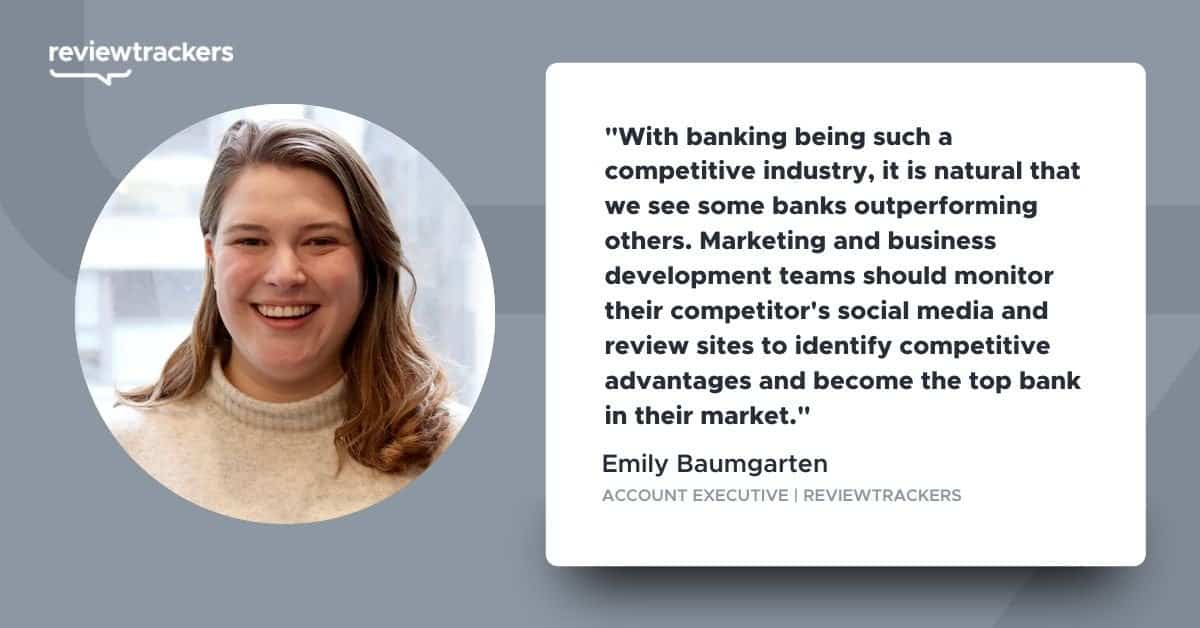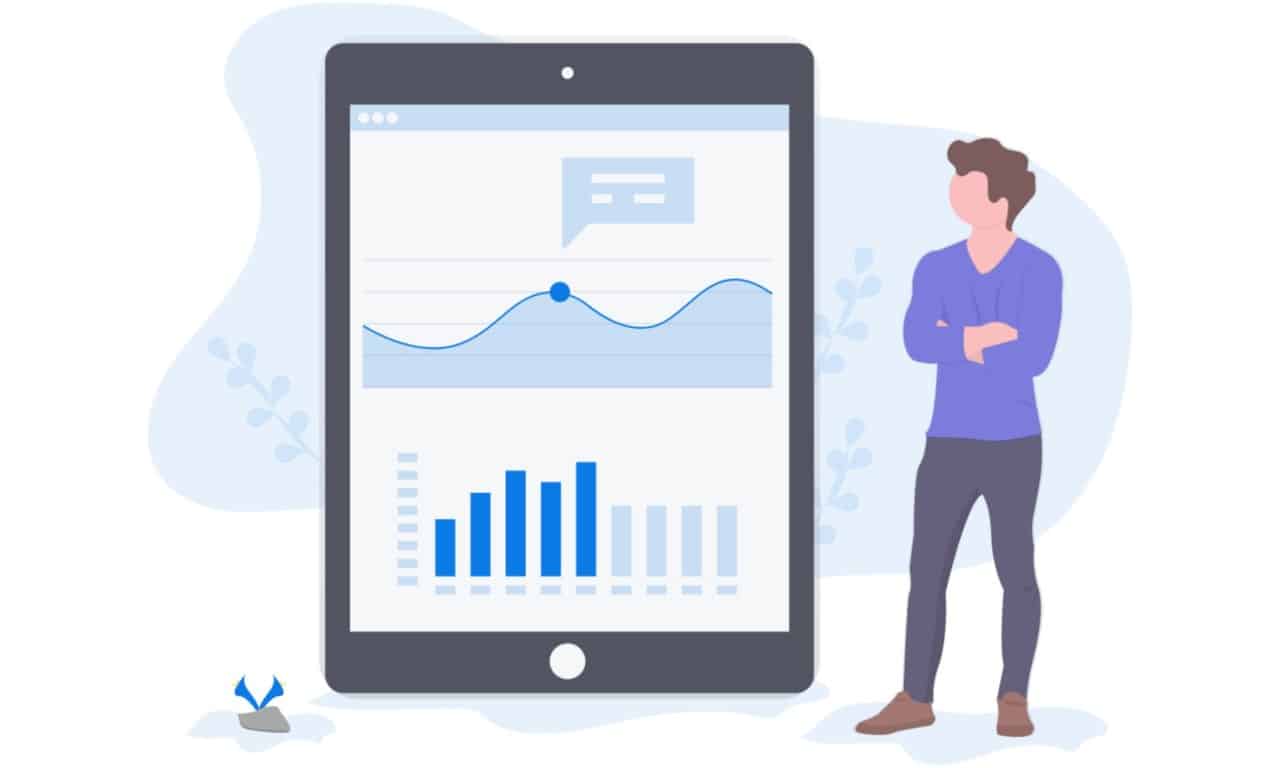A competitive analysis in banking is vital in a crowded industry. Today, financial institutions continue to face a mix of challenges such as frequent regulatory changes, heightened customer scrutiny, reputation damages, and the never-ending task of ensuring consumer loyalty.
To face these hurdles, banks need to provide more than a diverse set of products and services. To truly succeed, banking institutions must conduct frequent competitive analysis to achieve a deeper understanding of their peers and the industry as a whole.
With competitive analysis, your bank can understand:
- What is your bank doing better than the competition? (so you can promote these assets)
- What is the competition doing better than your brand? (so you can foster improvements)
- What are popular industry trends and how are disruptive competitors adjusting to the regulatory environment? (so that you may pivot quickly when needed)
- Which content strategies (i.e. social media, surveys, public testimonials) are working for the competition? (so you can discover trends and apply best practices)
- What mistakes are your competitors making? (so you can take advantage and differentiate your services)
Steps to an Effective Competitive Analysis in the Banking Industry
According to HubSpot, the financial industry has the third-highest average customer acquisition cost at $303. Taking the time to measure your bank accurately against the competition can lead to better customer retention and improved product offerings and services.
Define Your Goals and Objectives
Competitive analysis in the banking industry starts with identifying the goals and objectives most important to your institution. Are you looking to improve your online brand presence or generate more leads and traffic? Do you want to deliver a different type of customer experience or generate more social followers, likes, and shares?
Although this might seem obvious, defining your goals and objectives narrows the scope of your competitive analysis efforts and allows for the purposeful collection of data to analyze and use for future strategies.

Know Your Market
After defining your goals, you’ll need to have a firm understanding of your specific market. Markets can be defined geographically, as determined by specific ZIP codes and block groups, or by population, which is defined by average age, income brackets, and educational attainment. Once you have a specific target market in mind, create a comprehensive list of banks and competing institutions in that market.
It’s also useful to categorize the types of competitors you have in that market into primary, secondary, and tertiary tiers. This separates banks whose services compete directly with yours from other financial institutions such as lenders, mortgage bankers, and insurance agencies that don’t compete with your bank in its entirety but may include a portion of your offerings.
Competitive intel can also be found in financial reports, company profiles, resources such as Dun & Bradstreet and Hoovers Stock market data, market research reports, and newspaper archives. Including these resources in your competitive analysis will complete the big picture view of the market and identify unique opportunities for your bank.
Compare Competitor Content
Competitors’ content strategies are a valuable piece of intel that should not be overlooked because 82% of consumers purchased a company’s products or services as a result of content marketing efforts. This strategy takes many forms such as:
- Blog posts
- Visual media (photos and videos)
- Press releases and news stories
- Social media posts
- Case studies and testimonials
- Webinars, podcasts, and slide presentations
- FAQs
By reviewing content strategies in the industry and their success in presenting the competition online, you can easily determine how to improve your own content plans to outperform those same competitors. Content marketing is a proven form of capturing customer attention and effectively allocating resources to content strategy will help attract a larger customer base.
Talk to Customers and Measure Your Reputation
Investing time and resources into reputation management for banking will help banks shape public perception of their products, services, and brands in ways that improve public and consumer trust. Banks can employ many reputation management benchmarks already familiar to them such as online reviews, social media comments, and customer feedback to run analysis, create expert content strategies, and bring in more customers

Devoting effort towards analyzing industry-wide social media, online reviews, and customer feedback grants a glimpse into the strategies of competitors. This public content also shows whether consumers are choosing to invest with your bank or your rivals, providing further insight into what customers value most in their banking experience.
However, banks should not limit online review and social media monitoring to their competitors. Employ the same tactics internally to evaluate how your own customers compare your bank to others in the same market.
One way to effectively gather feedback is with customer surveys. In fact, 33% of businesses that use surveys portray themselves as more successful. By proactively collecting feedback these institutions are equipped with the actionable data and insights needed to improve their products and services. Surveys, comments, and reviews help evaluate loyalty and satisfaction, while also identifying and managing any high-impact issues and weaknesses.
For further information, you can read up on ways to create an effective customer feedback system, learn how to start asking for reviews, and foster an online presence through community management.

Keep an Eye on the Future
The financial services industry is disruptive, and banking is not immune to the frequent changes permeating the market. The emergence of robo-advisors like Ellevest, Betterment, and Sofi, as well as apps such as Alipay, WeChat, and Amazon Cash has introduced non-traditional competitors that force the banking industry to be responsive to a new and previously unseen set of customer needs.
Due to its disruptive nature, it is imperative that banks stay versed on all new industry trends. As new topics show up and gain traction, monitoring the appearance of emerging competitors can provide insight into the future of the industry. Ask questions like, “How can a new company lure customers away from my brand?” or “What are my competitors doing to tweak their offerings and shrink my competitive moat?”
The digital transformation in financial services is easily the largest, and most successful, trend banking has seen in decades. An Accenture study found that digitally-focused banks had a larger gap between cost and revenue than their more traditional competitors. By asking questions, monitoring industry trends, and surveying your own customers, your bank can find new ways to further widen that gap and be the go-to bank in your market.
Iterating on Your Competitive Analysis in the Banking Industry
A strong competitive analysis creates an advantage for your bank and widens its moat. This type of research not only provides insights on possible new improvements but also reveals an understanding of your bank’s own reputation.
Banking is already ranked second to last among 15 industries in terms of trust, and understanding how consumers react to a competitor’s products and services through multiple channels is an effective way to identify areas of improvement in your own customer experience.